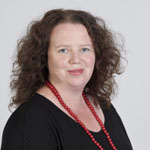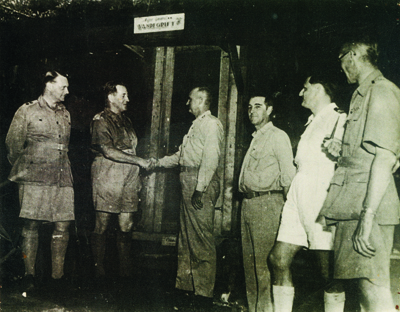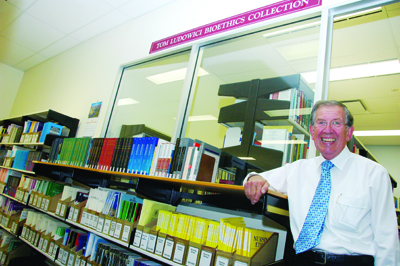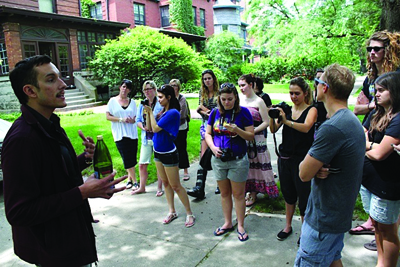Since 2009 Avondale has hosted a number of conferences and symposia exploring issues of significance to the church and the wider community.
A major conference entitled Understanding Islam from a Christian Perspective (2009) featured high-profile scholarly presenters, most of whom have lived and worked in Islamic countries, and all of whom have engaged in faith dialogue with Islamic leaders. The conference, chaired by Dr William Johnsson, former editor of Adventist Review, examined common ground and differences between Islam and Christianity, exploring ways of relating to Islamic peoples.
A 2011 conference entitled Church and Adventist Identity in the 21st Century explored issues of identity in relation to the question of how the church might relate relevantly to the contemporary world. Pastor Rudy Dingjan, Church Growth Director for the Seventh-day Adventist Church in the Netherlands, and Pastor Peter Roennfeldt, who has cultivated church planting movements in up to fifty countries, shared their experience of fresh approaches to planting new churches in sophisticated cultural environments. Dr Reinder Bruinsma, an academic, author and retired church administrator from the Netherlands, spoke of the cultural legacy of postmodernism. “This is not a matter of thinking differently about a few things but a completely different way of looking at life,” he said. “Innovative approaches are needed to interface with contemporary culture and society.”
The Manifest Creative Arts Festival (2011), organised by the Adventist Church in the South Pacific through Avondale College of Higher Education and the Adventist Media Network, highlighted the importance of the creative arts in communicating the gospel; fostered creativity in writing, film making and music; and provided opportunity for creative artists to connect with one another and showcase their work. “Too often we underestimate the importance of the arts, but these are integral to communicating our message of hope,” said Neale Schofield, chief executive officer of Adventist Media Network. “Creative artists need to be recognised and we need to create a space for them to flourish in the church.” The event climaxed with the Gabe Reynaud Awards, named in honour of the talented film maker and former senior producer at Adventist Media Network whose life was cut tragically short. Visiting presenters included Kay Rizzo, author of over fifty books and one of the most prolific Adventist writers, and Stacia Wright, co-founder of the annual SONscreen film festival organised by the Seventh-day Adventist Church in North America.
Symposium on origins issues
In 2011 Avondale hosted a weekend symposium on origins issues, sponsored by the Faith and Science Council of the General Conference of the Seventh-day Adventist Church.
Dr Ross Grant, a biochemical pharmacologist at the University of New South Wales and chief executive officer of the Australasian Research Institute, argued that an adequate theory of origins requires an explanation for the origin of the precise physical and chemical laws that govern space, time and matter. It also requires explanations for the origin of life, the development of increasing genomic complexity, and the simultaneous development of the symbiotic environment (ecosystem) needed to sustain the forms developed. With reference to genomic complexity, Dr Grant noted that while natural selection can produce variations, there is no evidence that it can add to the complexity of the genome.
Dr Timothy Standish, a biologist in the Geoscience Research Institute at Loma Linda University, California, noted that many of the earliest fossils exhibit biochemical complexity such as photosynthesis at their first appearance in the fossil record. Many early fossils also show anatomical complexity at their first appearance. Trilobite eyes, for example, appear in full complexity with no prior evidence of having gradually evolved.
Dr Raul Esperante, a palaeontologist in the Geoscience Research Institute, reported research by an Institute team at a site in southern Peru where over five hundred well-preserved fossil whales, together with other large marine animals, were found in an area of three square kilometres of mountaintop. The evidence indicates rapid and catastrophic burial. The fossils are typically in pristine condition, with no marks of scavenging or erosion of the skeleton. When whales die naturally in the ocean, the baleen tends to detach from the upper mandible within hours or days of death; but in the Peruvian fossils, more than seventy-five whales were found with the baleen still intact. Dr Esperante noted that a majority of palaeontologists now believe that the geological record shows evidence not of uniform change, but of gradual depositions interspersed with repeated local catastrophes.
New Perspectives on Christianity
conferences
Avondale hosted two New Perspectives on Christianity conferences (2009, 2011), each of which developed a stimulating range of Christian viewpoints on contemporary issues, including presentations on Christian witness, indigenous issues, biblical scholarship, organisational leadership, education, health and the visual arts. Selected papers from the New Perspectives conferences are published in The International Journal of New Perspectives on Christianity, a refereed journal published by Avondale College of Higher Education. The Journal is also available on the Avondale website at ResearchOnline@Avondale (http://research.avondale.edu.au). The editorial outlines the objectives of the journal. Information for authors is also available in the journal and articles are invited at any time in addition to the papers presented at the conferences.
Christianity’s potential contribution to contemporary society
In a keynote address to the 2009 conference, Dr Vivienne Watts, Avondale’s Vice President (Administration and Research), proposed community engagement as a way forward for Christianity in the context of declining religious affiliation in Australia. Christianity, she said, can demonstrate its relevance to contemporary society by addressing community challenges, needs, issues and problems. Just as they did in the past, Christians can become advocates for transformational societal change by working together in the community and for the good of the community under a framework of factors that will sustain Christianity’s survival. These factors include maintaining relevance, holding common beliefs, having a common purpose, and feeling that their Christian faith is both worthwhile and will provide strength in times of trial.
Nathan Brown (Adventist Media Network) argued (2011) that credible Christian witness is relational (communicated via friendships), authentic (Christians living their principles), committed to social justice (righting the wrongs in the world), local and contextual in operation, and characterised by the beauty of the new creation unfolding in people’s lives.
Associate Professor David Tacey (LaTrobe University) proposed (2009) that one way Christianity can increase its relevance in Australia is by showing leadership in the debate about the ecological crisis.
Early Christian witness
At the 2009 conference Professor Alanna Nobbs, head of Macquarie University’s Department of Ancient History, discussed the impact on the lives of ordinary Christians in the reign of the emperor Decius (AD 249-251) of the Roman government’s attempts to enforce traditional rites and sacrifices which the authorities regarded as important in holding the state together. Christians typically resisted these requirements, their stand in general attracting admirers and support.
Dr Bruce Manners, pastor of the Avondale College Church, argued (2011) that factors contributing to the rapid growth of early Christianity suggest effective ways for Christians to influence the post-Christian world. The beliefs of early Christianity were attractive because they gave meaning to life and hope for the future. Christians also lived ethically. They cared for those around them, even risking their lives to help people suffering in epidemics. They exemplified principles of social justice, valuing women and children, caring for widows, and holding slave and noble of equal value in God’s sight. In all these ways they bore witness to a loving God. An important factor in the rapid growth of early Christianity was its dissemination via personal friendship and example.
Indigenous issues and Christianity
At the 2009 conference Graham Fletcher, Queensland member of the National Native Title Tribunal, proposed some implications for Christian faith and practice drawn from his experience in mediating native title issues. The importance of place and belonging for all cultures and peoples gives special significance to God’s promises assuring believers of their right to a position in His family and His place. Fletcher argued that because reconciliation is offered by God and has been given to us as a ministry (2 Cor 5:17-20), Christians have an obligation to support and be among the leaders of reconciliation in our nation. Fletcher also pointed out that in Australian law native title is a pre-existing right, subject to continuous use of the land for traditional cultural activities. In a similar way, practising Christians may confidently plead a right to a place in God’s kingdom, achieved for them by Christ.
Biblical scholarship
Dr Sook-Young Kim, author of The Warrior Messiah (Cambridge Scholars Publishing), showed (2011) that phrases in verses 1 and 12 of Isaiah 53 denote a royal Messiah figure who has won victory in battle and is apportioning the spoils. The victory has been won not by military means, but by suffering and dying as a sin-bearing sacrifice, by means of which many are made righteous (verses 11, 12). Dr Sook-Young Kim is also a conjoint lecturer of Avondale College of Higher Education.
Organisational leadership
Dr James Osterhaus, a senior partner in TAG Consulting USA, explored (2011) some of the tensions confronting leaders of organisations, noting that authentic leaders are committed to the values of their organisations and make decisions consistent with those values despite the competing pressures. Dr Osterhaus is a clinical psychologist experienced in helping individuals and organisations work through change, conflict and reorganisation. He has authored eight books on these and related subjects.
Education
Associate Professor Phil Fitzsimmons (School of Education, Avondale) presented the results of a year-long study of a class of twenty-two adolescents in a secular “progressive” school where students had the freedom and openness to explore issues of interest to them. Despite the students’ apparently secular orientation, it emerged that they were deeply interested in spiritual matters. They continually initiated discussions that were spiritually focused, exploring the meaning of life and their place in it in a quest for spiritual, emotional and social understanding. In the process they became aware of markers of identity that they believed should characterise how they should live their lives. The study tended to support the researcher’s view that the secular focus of young people is a façade and that they are in fact more spiritually oriented than previous generations. The findings raise important questions of how future generations might view and understand Christianity, and of how the Christian church should change to interface with a spiritual generation that is largely non-religious.
Dr Don Roy, long-time Adventist educator, developed a model of the values and special character of Christian schools as communities of faith, which he proposed as a useful frame of reference to facilitate critical evaluation, strategic planning and renewal in Christian schools.
Health
Dianne Sika-Paotonu presented a paper based on her PhD research on designing cancer vaccines, carried out at the Malaghan Institute of Medical Research in New Zealand. These cancer vaccines are dendritic-cell based and work by stimulating the immune system to destroy cancer tissue. It has been found that the dendritic cells of cancer patients are often not working properly, which means that signals needed by the immune system to generate cancer-killing cells are not produced. When dendritic cells work well, they are capable of converting resting T-cells into cancer-killer T-cells. Dianne’s work showed that dendritic cells were able to work harder and produce more cancer-killer T-cells when the dendritic-cell based vaccine preparation contained a sea sponge extract. This groundbreaking research won for Dianne the 2008 Health Research Council of New Zealand MacDiarmid Young Scientist of the Year Award in the category Advancing Human Health and Wellbeing. Dianne is currently a lecturer in pharmacology at the Graduate School of Nursing, Midwifery and Health, Victoria University of Wellington, New Zealand.
Dr Ross Grant, a pharmacologist, neuroscientist and specialist in degenerative diseases in the School of Medical Sciences, University of New South Wales, presented a paper identifying lifestyle choices that can greatly reduce the incidence of the degenerative diseases that account for 95 per cent of the causes of death in Australia. Among the lifestyle factors associated with degenerative disease he noted inadequate intake of nutrient-rich foods, excessive intake of high kilojoule foods, inadequate exercise, high stress levels, and smoking. He also showed that vigorous exercise of at least thirty minutes per day not only benefits the cardiovascular system, but also switches off the HPA axis involving the hypothalamus, pituitary and adrenals, reducing the craving for food and the liability to degenerative diseases associated with obesity.
Visual arts
Dr Richard Morris, a senior lecturer in Avondale’s School of Humanities and Creative Arts, observed that Protestants have tended to privilege the printed and spoken word above the visual arts and to prefer realism in art above abstraction, which many have seen as mysterious and by extension, threatening to concepts of truth. In contrast to such views, Morris examined the impact of abstraction in Colin McCahon’s religious painting Victory Over Death 2. On the surface, the painting appears to consist merely of painted words. Morris showed how the opposition of light and darkness in the painting creates a bridge between its verbal symbolism and abstraction, providing the viewer with an enriched appreciation of the cross of Christ and its significance.




